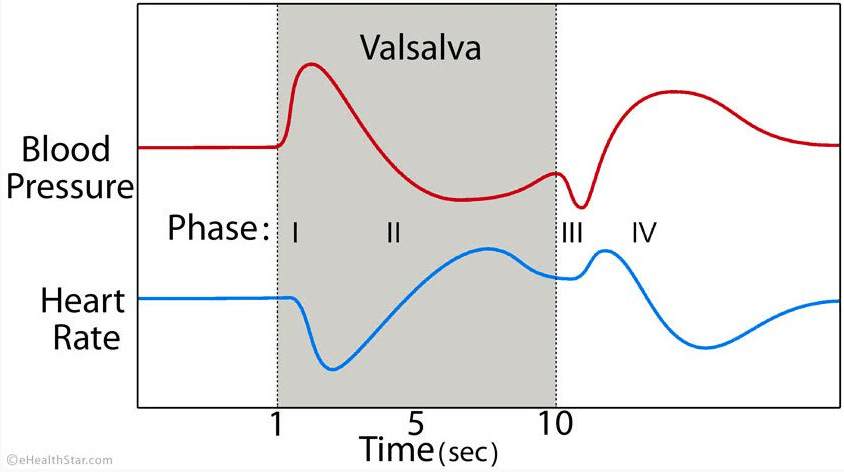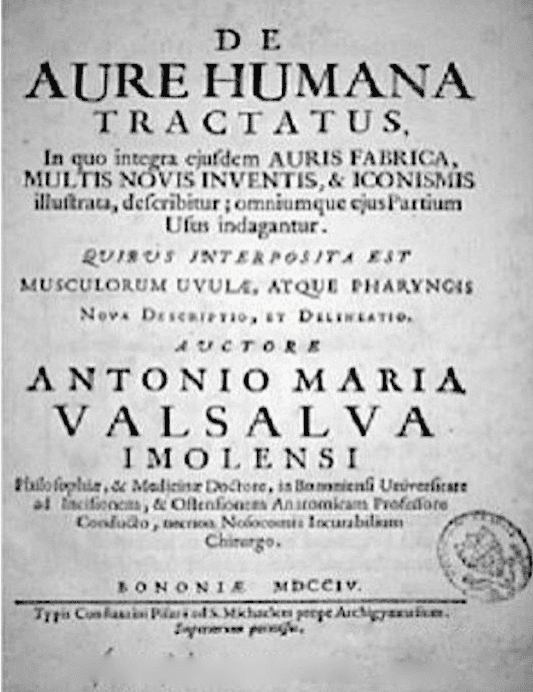JMS Pearce
Hull, England, UK
 |
| Fig 1. Valsalva’s maneuver. Source |
It is a paradox that the discovery of the Valsalva maneuver did not relate to cardiovascular physiology but to the treatment of discharges from the ear. Valsalva’s maneuver is now used physiologically1 to test cardiac and autonomic function, and in several other diagnostic and therapeutic procedures. The surgeon Leonard of Bertapaglia (c.1380-1463) made similar observations before Valsalva.
The Valsalva maneuver is a well-known physiological technique in which the subject gives a forced expiratory effort against a closed airway (glottis) for fifteen to twenty seconds. Consequently, there is an increased intrathoracic pressure raised to about 40 mm Hg., and raised right atrial pressure with resultant jugular venous distension. It occurs in trumpet playing2 and whenever there is forced expiration against a closed glottis or high pulmonary outflow resistance, or when the thoraco-abdominal muscles are strongly contracted, for example when a person strains at stool or lifts heavy weights while holding their breath.3 It is useful in clearing ears that feel blocked during descent in airplanes.
Physiologically,4,5 four phases are described6 (Fig 1). The first is increased intrathoracic pressure that expels blood from the thoracic vessels. There follows reduced venous return to the heart, reduced cardiac filling and cardiac output; compression of the thoracic aorta increases aortic pressure, which then falls. The baroreceptor reflex determines changes in heart rate reciprocal to changes in aortic pressure. The final release of the maneuver restores venous return with compensatory overshoot and bradycardia.
Antonio Maria Valsalva (1666–1723)
|
||
| Fig 2. Left, Valsalva: From the National Library of Medicine. Right, De Aure Humana Tractatus. |
Valsalva (Fig 2) was an eminent anatomist and surgeon in Bologna, the oldest Western university, founded in 1088 and a center of intellectual life during the Middle Ages.7 Few can rival his famous connections: as a pupil of Marcello Malpighi (1628-1694) then as tutor of Giovanni Battista Morgagni (1682-1771).
As a teenager, he studied philosophy, mathematics, and medicine at Bologna University. He became the favored pupil of Malpighi (father of microscopical anatomy and embryology). He graduated in June 1687, with a thesis entitled Sulla superiorità delle dottrine sperimentali [On the superiority of experimental doctrines]. He was immediately appointed Inspector of Public Health in Bologna.
He practiced at the Ospedale degli Incurabili in Bologna for twenty-five years, working in ophthalmology, rhinology, and surgery. To test and refine his clinical diagnoses he performed many autopsies; he also recognized the importance of compassionate treatment for the mentally ill. Noted for his anatomical studies of the aorta, the aortic (Valsalva’s) sinus was named after him by his devoted pupil Morgagni, who collected his anatomical works.8
His clinical acumen, skill, and anatomical knowledge established a formidable reputation. Indeed, the Pope wanted to appoint him his personal physician, but Valsalva preferred to continue work at the university, to teach and experiment. The Senate of Bologna elected him Professor for Dissecting and Demonstrating Anatomy in 1697.
In 1709, he married Elena Lisi, aged only seventeen; they had six children, but three died in childhood. While still clinically active he probably had a transient ischemic attack, which he regarded as a minor apoplexy. Two years later he died from apoplexy, aged fifty-seven, in February 1723.
His book De aure humana tractatus (Treatment of the human ear) was published in 1704.9 In it he was the first to describe the inner, middle, and external parts of the ear, and the structure and function of the Eustachian tube, which he named after its discoverer, the anatomist Bartolomeo Eustachi (c. 1513–1574). He minutely described the tiny muscles and nerves of the ear. The book became the standard otology text for over a century.
Valsalva’s maneuver
In patients with brain abscesses and head injuries, Valsalva had observed the drainage of pus and blood, respectively, through the ear, which he attempted to explain:
. . . I will explain about the expurgation of preternatural cranial matters: he who has inflated his mouth and nose allows air to reach as far as the dura mater. It is clear that these foramina permit relief by extruding sanies [bloody matter] in penetrating head injuries from the cranial cavity through the wound —dum clausis naribus et ore aer vi intro comprimitur [when through closed nose and mouth air is forced inwards]. In fact by the same effort air is forced through the Eustachian tube to the tympanum and backwards through the foramina against the brain . . . demonstrated not once but by frequent experiments . . . A sore of the tympanum whence ichor [watery discharge from a wound] flows into the auditory meatus . . . if with occluded mouth and nostrils air is compressed inwardly, this action will extrude sanies from the middle ear [and is] a remedial exercise, to be repeated, [and will lead to] extrusion of preternatural cerebral matter either via the wound, via the nostrils, via the mouth, or via the auditory meatus . . . with great benefit . . . 9,10,11
In his account, he describes the use of the maneuver to drain intracranial and middle-ear fluids via the then commonly perforated eardrum, and he deduced the presence of non-existent foramina between the ear and cranial cavity. De aure humana tractatus was republished in Utrecht in 1707 and a third edition in Geneva in 1716. His former pupil Morgagni republished the book and several of Valsalva’s works in Opera Valsalvae et dissertationes anatomicae, 1741.11
Almost one hundred and fifty years later in Leipzig in 1850, the brothers Eduard Friedrich and Ernst Heinrich Weber reported a Valsalva-induced blackout:
I could interrupt at will for a moment, the beats of my heart and pulsations of my arteries by hindering the air from entering into my chest which I was at the time compressing; . . . One day, when I held my breath a little longer than usual . . . I lost consciousness . . . my assistants noted some convulsions . . . 4
Together they had previously shown that vagal nerve stimulation in the frog induced bradycardia; they then proposed the cardiovascular mechanisms in man that we apply today. In 1823, before the Webers, the artist Giovanni Ceccarini had shown the Valsalva maneuver in his sculpture the Fountain of Neptune in the Piazza del Popolo in Rome where a Triton blowing his conch has a distended right external jugular vein.12
Valsalva did not anticipate the applications of his maneuver that subsequently advanced the understanding of the circulation10 and has been extensively investigated and used in several clinical disciplines. Jellinek11 succinctly refers to his “false eponymity and true fame.”
Reference
- Sharpey-Schafer EP. Effects of respiratory acts on the circulation. In: Handbook of Physiology, Vol. 2, Sec 3: Circulation. Washington, DC: American Physiological Society, 1965.
- Faulkner M, Sharpey-Schafer EP. Circulatory effects of trumpet playing. Br Med J 1959;1(5123):685–6.
- Sinisalo J, Rapola J, Rossinen J, Kupari M. Simplifying the estimation of jugular venous pressure. Am J Cardiol 2007;100(12):1779–81.
- Weber EF. Sur des essais d’arrêt volontaire de la circulation du sang et des fonctions du coeur. (Extr) Arch Gén de Méd 1853;i:399–411.
- Madhavan AA, Carr CM, Carlson ML, Lane JI. Imaging Findings Related to the Valsalva Maneuver in Head and Neck Radiology. Am J Neuroradiol. 2019;40(12):1987-93.
- Pstras L, Thomaseth K, Waniewski J, Balzani I, Bellavere F. The Valsalva manoeuvre: physiology and clinical examples. Acta Physiol (Oxf) 2016;217(2):103-19.
- Pearce JMS. Foundations of Anatomy in Bologna. Hektoen Int Fall, 2017.
- Morgagni G B. De vita et scriptis Antonii Mariae Valsalvae commentariolum. Venice, 1740.
- Valsalva AM. De aure humana tractatus. Utrecht: van de Water, 1707.
- Derbes VJ, Kerr A. Valsalva’s maneuver and Weber’s experiment. N Engl J.
- Jellinek E H. The Valsalva manoeuvre and Antonio Valsalva (1666–1723). J R Soc Med 2006;99:448–451. https://journals.sagepub.com/doi/pdf/10.1177/014107680609900915.
- Gelfman DM. The Valsalva Maneuver, Set in Stone. Am J Med. 2021 Mar 4:S0002-9343(21)00146-7.
JMS PEARCE is a retired neurologist and author with a particular interest in the history of science and medicine.



Leave a Reply